
noMad proposes a behavioural fabrication system that marks a shift of our build environment as a finite lifecycle construct, but is instead looking for autonomous, non-finite and real-time solutions to adapt dynamically to the demands of its environment - constantly restructuring itself.
In a self-assembling fabrication approach of ‚negotiated space‘, noMad aims to enable architecture with a sensory system, localising decision making by self-aware unit to unit communication instead of a deterministic, superimposed building plan.
Anchored in the world of self-structuring polyhedra, noMad is based on principles of synergetics, the study of geometry in transformation and the impact of a local change on its global systems behaviour: a single unit can autonomously change state, shifting its state by a simple rotational translation from one polyhedra to the other.
Hereby, noMad is operating on different scales of (collective) intelligence and behaviour, each autonomously self-assembling to the next higher order of organisation - from a highly mobile, nomadic states to high population spatial configurations.
noMad proposes a system, that can self-regulate and adapt, react to outside influences and demands and encourages both interaction and communication.
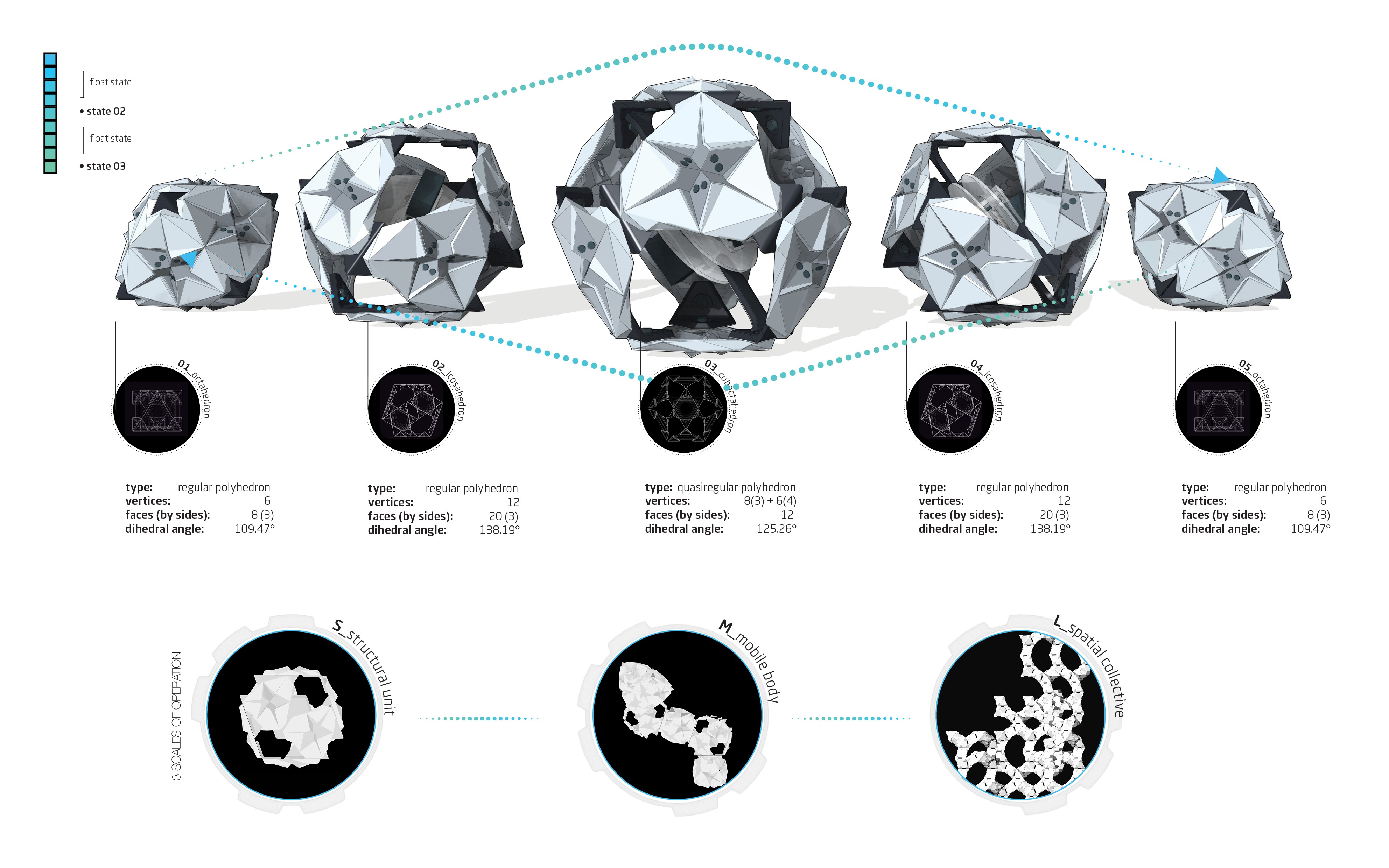
scales of operation |
Through the use of active and passive geometry shifting components the system can reconfig- uring its global behaviour. Based on self-struc- turing qualities of polyhedra, the research is engaging the issues of mobility, self-structuring and space-making.
When applied, noMad’s system of assembly operates on three distinct scales of intelligence and autonomy. Each scale is autonomously self-organizing and self-assembling to reach its next higher order of organization.
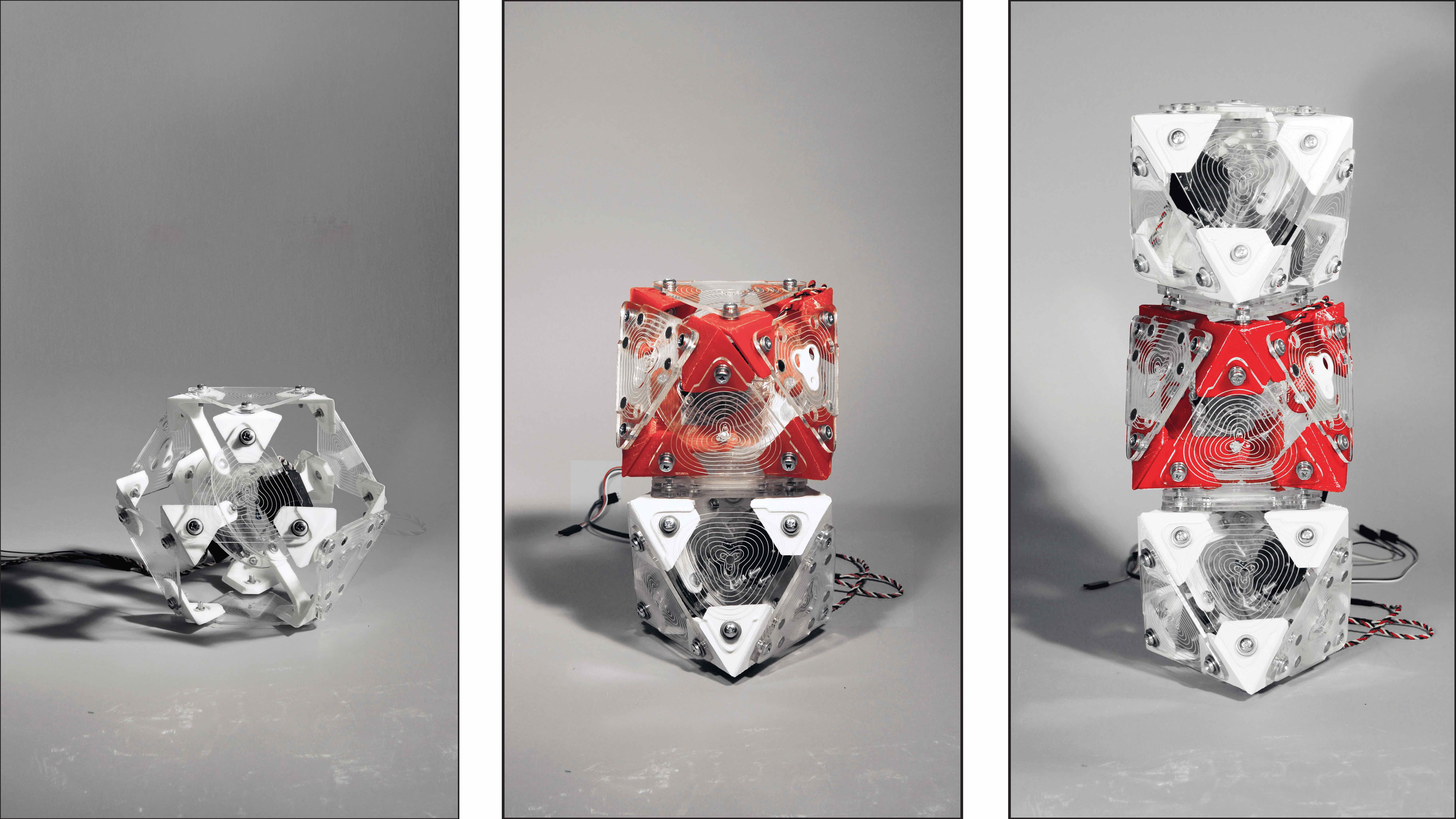
01 - single unit |
Beginning from its smallest operational scale, the single unit, the system is still capable of sim- plest decisions and actions, such as changing the state of the unit, limited locomotion, connecting and disconnecting from an global system. The unit is the main building block, based on a simple rotational movement of the faces of an octahedron around the vertices of its neighbor. Within this transformation, the unit starts from octahedral state, expands to an icosahedron, cuboctahedron, back to icosahedron an and octahedron again. Central design features focus on the activation of the single unit through internal controls and mechanics, possibilities of the single unit to self-connect and disconnect to system, mobility through locomotion, soft faces and control over its internal equilibrium.
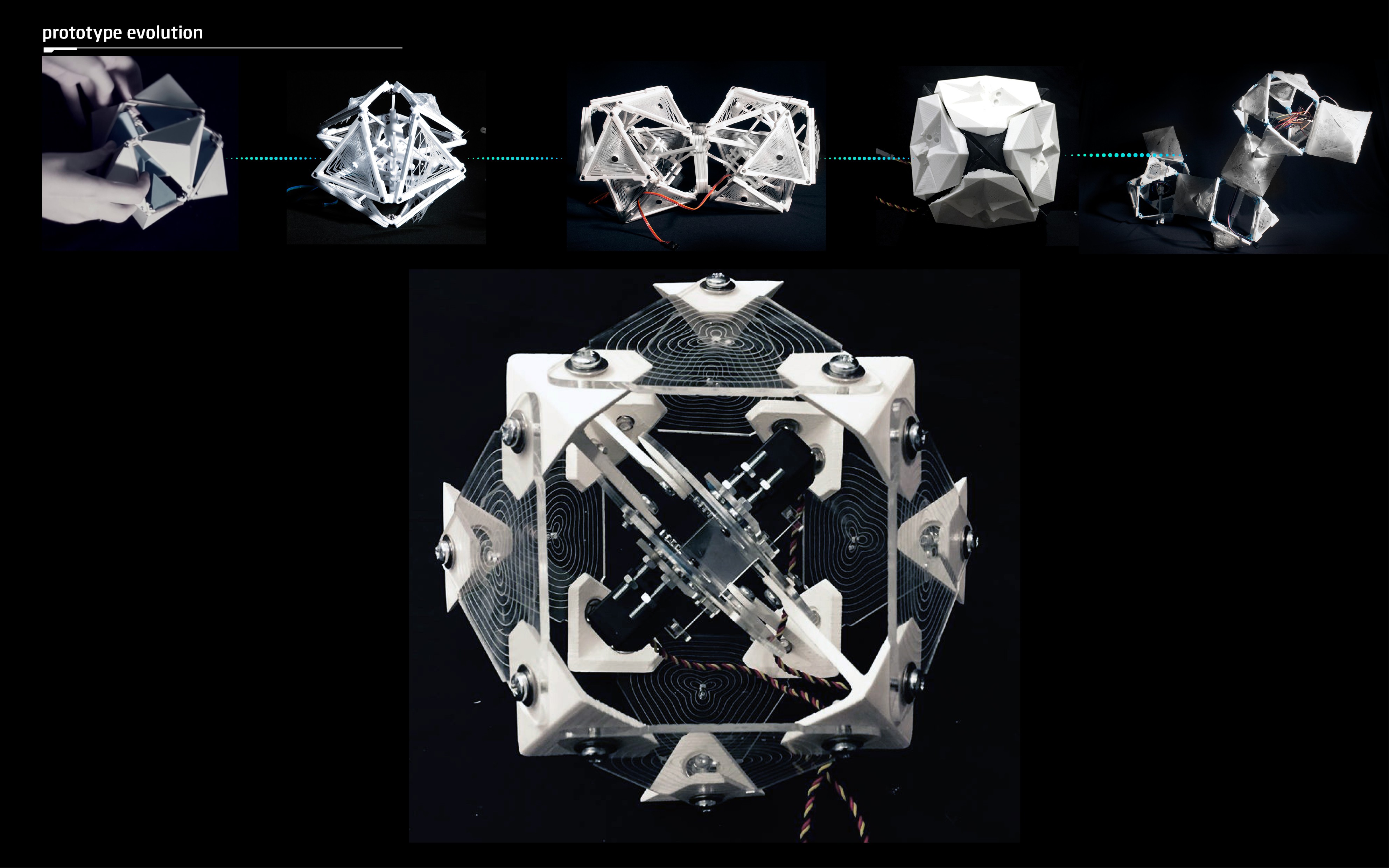
02 - nomadic body |
The formation of nomadic bodyplans - both through detrministic and stochastic means - is where the intelligence of the system starts. A logic of potential shape grammar combinations is defines the body like a genetic sequence:
The ecology of machines shows creature-like characteristics and highly specific behaviour both due to their individual bodyplans, i.e. the physical body, and its sequence of activation, i.e. choreography of movement. The choreographies enable features and abilites such as lifting mat- ter, walking or snake-like locomotion, rotational or translating arms and cranes etc.
Only a few of used components having active capacities while the rest of the structure reacts passively.
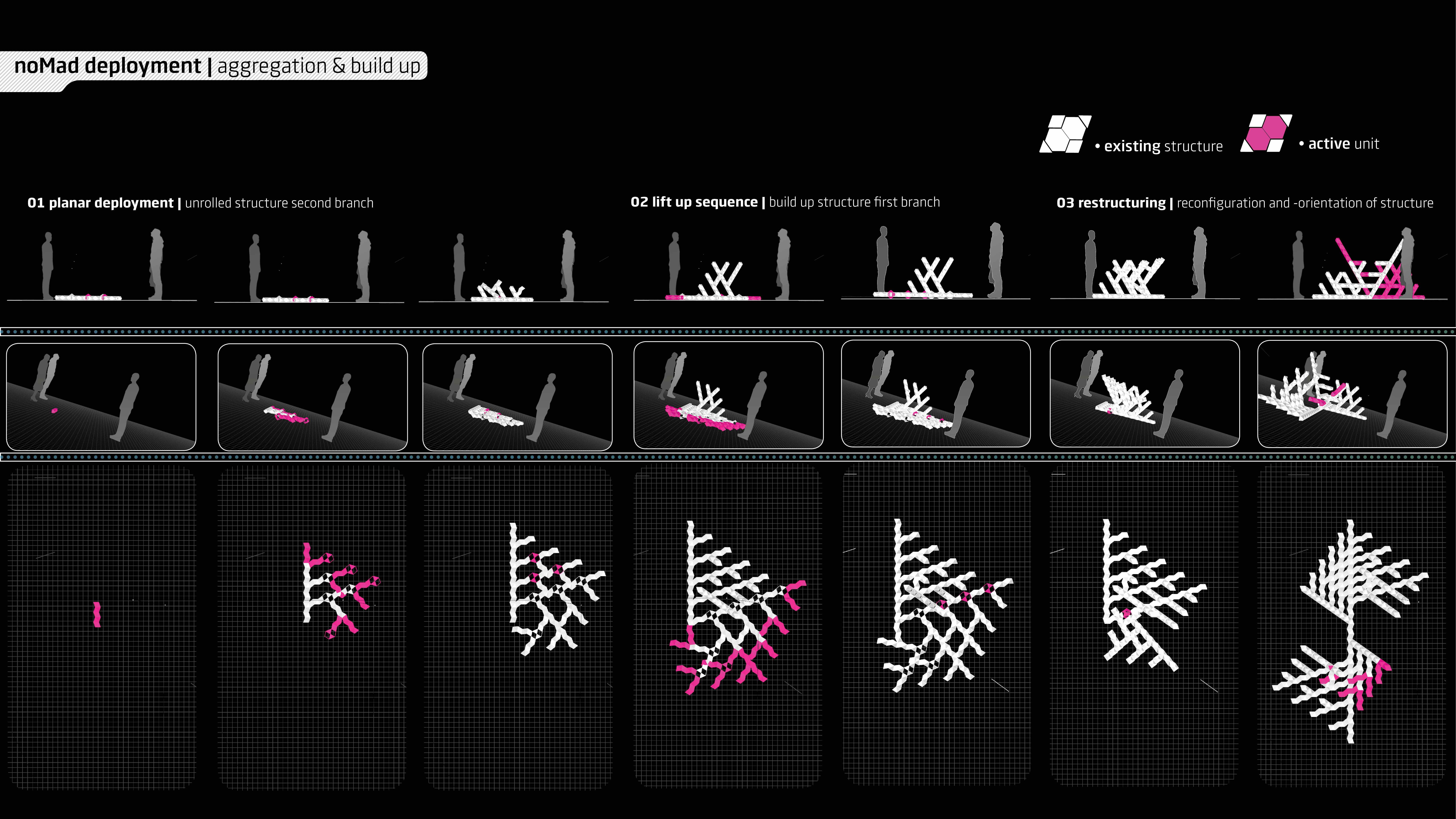
03 - high population collective |
In the scenario of high population settlements, parts of the system lock in, losing their highly mobile features in favor of spatial and structural configurations. Transformation is now used for optimization & adaptation through reconfigu- ration, i.e. temporary scaffolds during its own build-up process, lifting up of extensions and outer parts of the structur, or temporarilty repo- sitioning to allow another body to get in place. Testing different deployment strategies and time based form finding through motion, fabrication driver of higher organisations is the catalogued behaviour of nomadic bodies - mean- ing every larger superstructure accumulation is defined by its multiple bodies coming together.
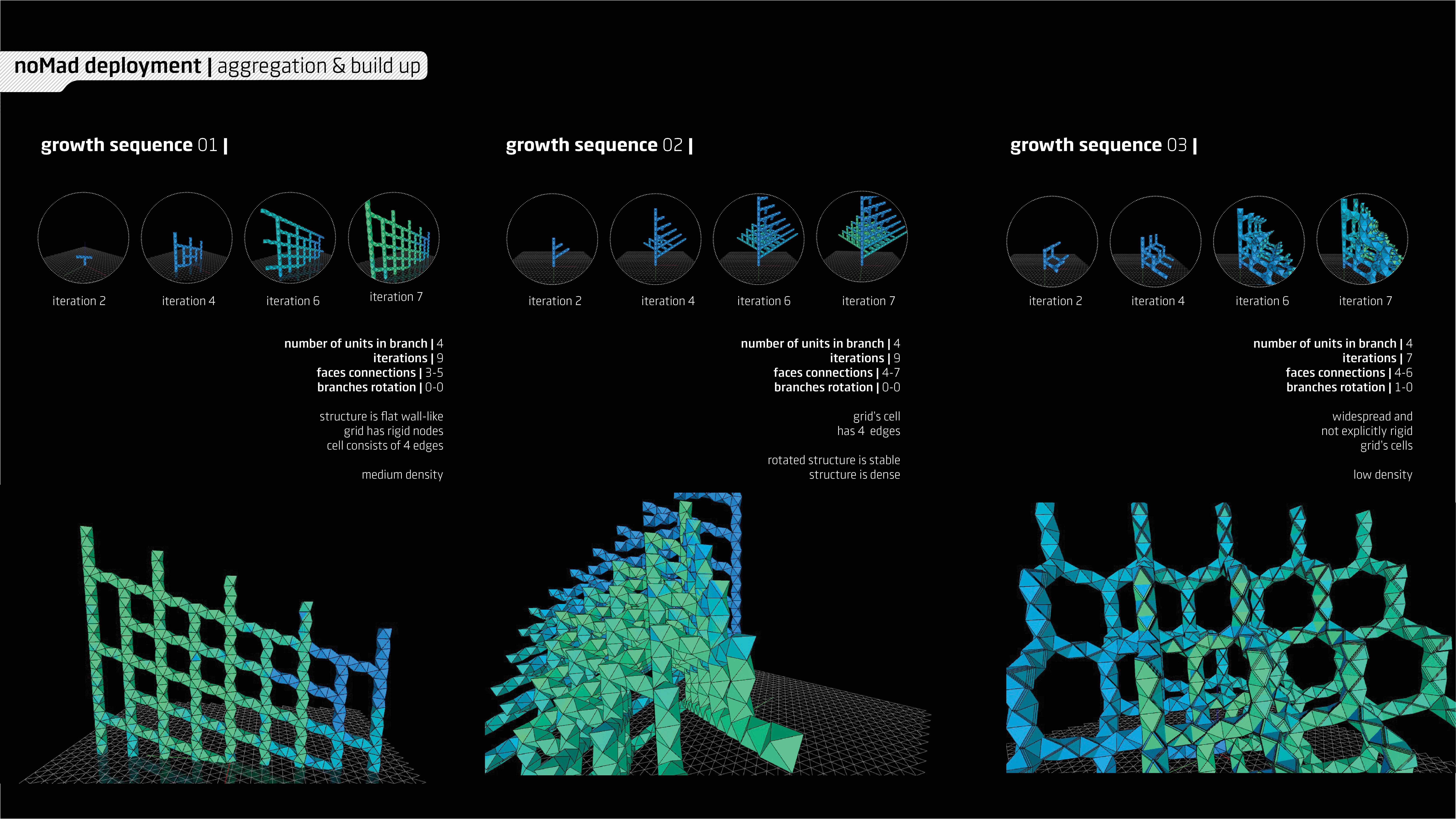

urban lifecycle |
The system goes through distinct phases of operational modi from varying degrees of mobility and urban interventions with architectural deployment. In everyday passive mode aggregations work as a distribution hub for other functions of urban scanning and intervention. Within their vicinity a hub sends out mobile no- madic bodies to explore with the agenda of data mining, scanning and evaluating the city using open source data infrastructure and an internal sensory system.
When a site for deployment is identified according to potential for building or urgency for intervention they report back to their hub to send of units on demand to migrate on site where the assembly and construction part as urban intervention takes place. After usage, the system disintegrates and migrates back to its distribution hub or other interventions.
In a full building lifecycle one can observe the various building strategies and capabi- lites of the system and how it is capable to adapt and react on each scale, from horizon- tal organization on the ground to build up a base for vertical build up and multiple deployments, the material itself actively climbing and deposited horizontally and vertically through existing structure. Units negotiating with already build structures and deploying new scaffolds along them or adapt reconfiguration without the need of new units entering the system, but a re-positioning of existing structures allowing new configurations. In an urban scenario, the system is adapting to changing needs and scenarios of deployment during the pass of the day, entering and leaving building sitse on demand and migrating on an urban scale.’.
noMad creates a living cycle of endless evolving scenario. We imagine noMad to be a part of the city integrated into its daily life, as an infrastructure responding to us on many scales.
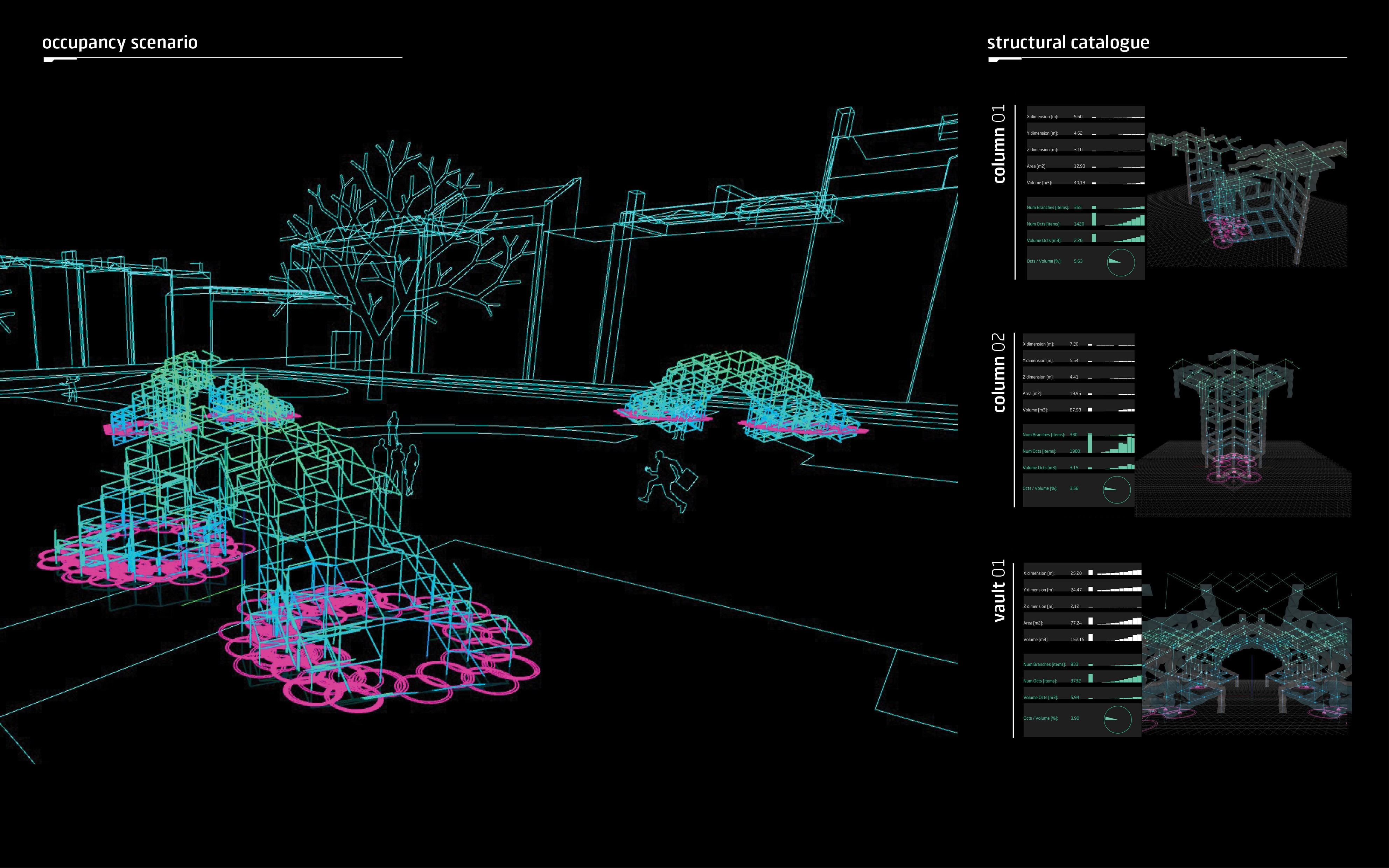
real time deployment |
By using open source platforms to harvest the digital layer of the city - the internet of things - the parts of the city and urban infrastructure that already openly talk to us,such as the tower bridge twittering its status of open and closeness, inform the and get into the conversation with our system to communicate the state of the city. A parametric map of London is used to live trace areas of interest for the system to deploy according to specific urban constraints - for example open spaces - and dynamic constraints - high convergence of people - to capture urban temporality. Collected data from the city (weather stations, participatory sensing of people and internet feeds) are made available in open source platforms like open street maps and xively and can be directly linked to urban analysis and direct input to both behavioural simulations and prototypes
Machinic Behaviour |
noMad’s research is concerned with the system’s machinic behaviour, including aspects of fabrication and simulation of material and physical behaviour of our system. Due to its space-packing, self-structuring and kinetic requirements, the system is grounded in the world of polyhedra and synergetics, the study of systems in transformation. The research deals with geometrical explorations, espe- cially transformational geometry, their spatial configuration, reconfiguration and locomotion and the common aim of making. The central focus of making aims to develop demonstrat- able prototypes within a streamlined process of fabri- cation. The physical design-proposal of a unit is tested with various approaches of embedded mechanics and constructions in order to activate and realiably control the systems movement. Digital simulations of global system behaviour resp. im- pact of local transformation on physical and mechanical behaviour are developed to catalogue emergent phenoma, both under space-making and structural - ‘static’ - criteria as well as ‘dynamic’ properties, i.e. reconfigurability, flexibility and mobility.
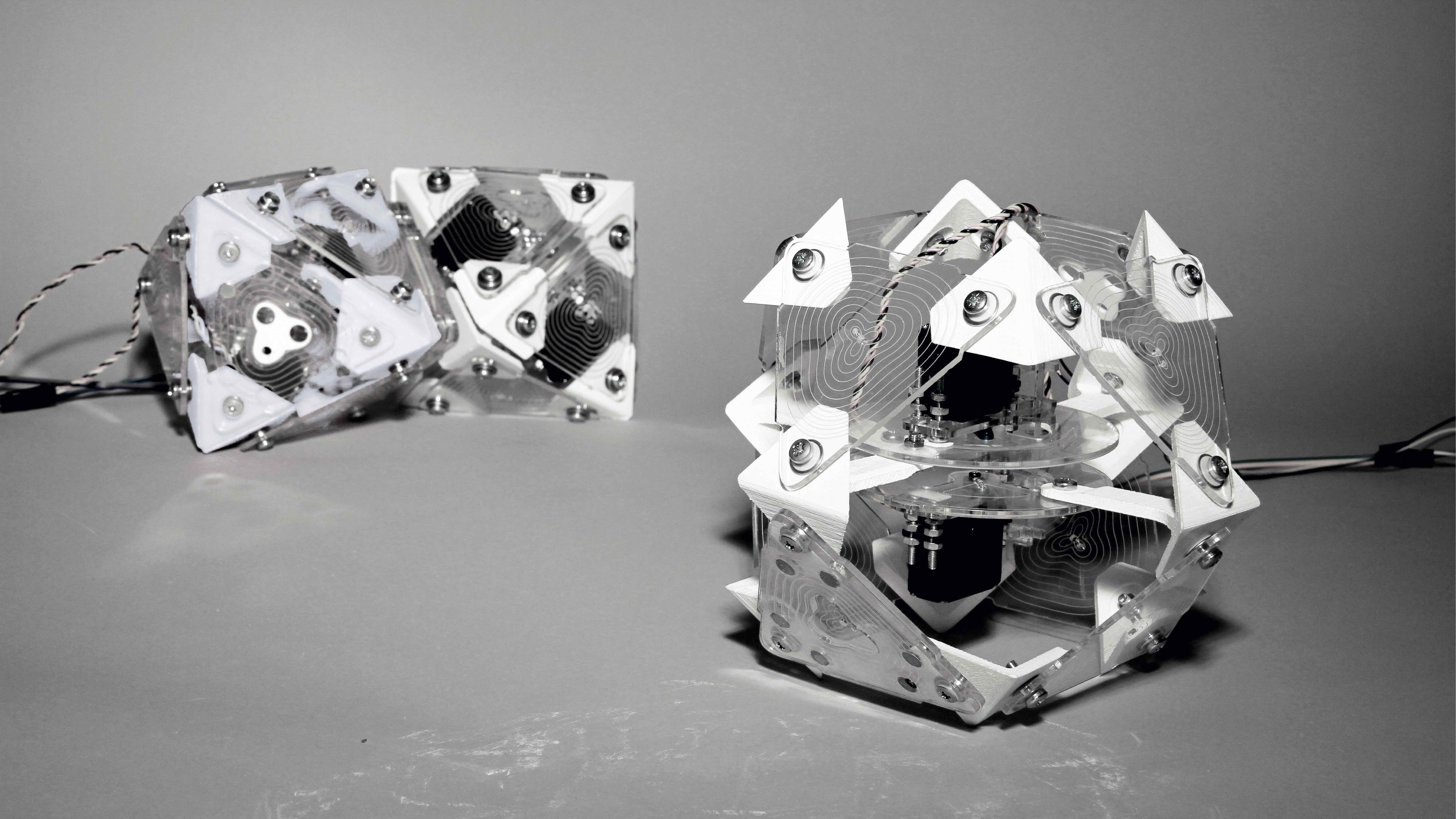
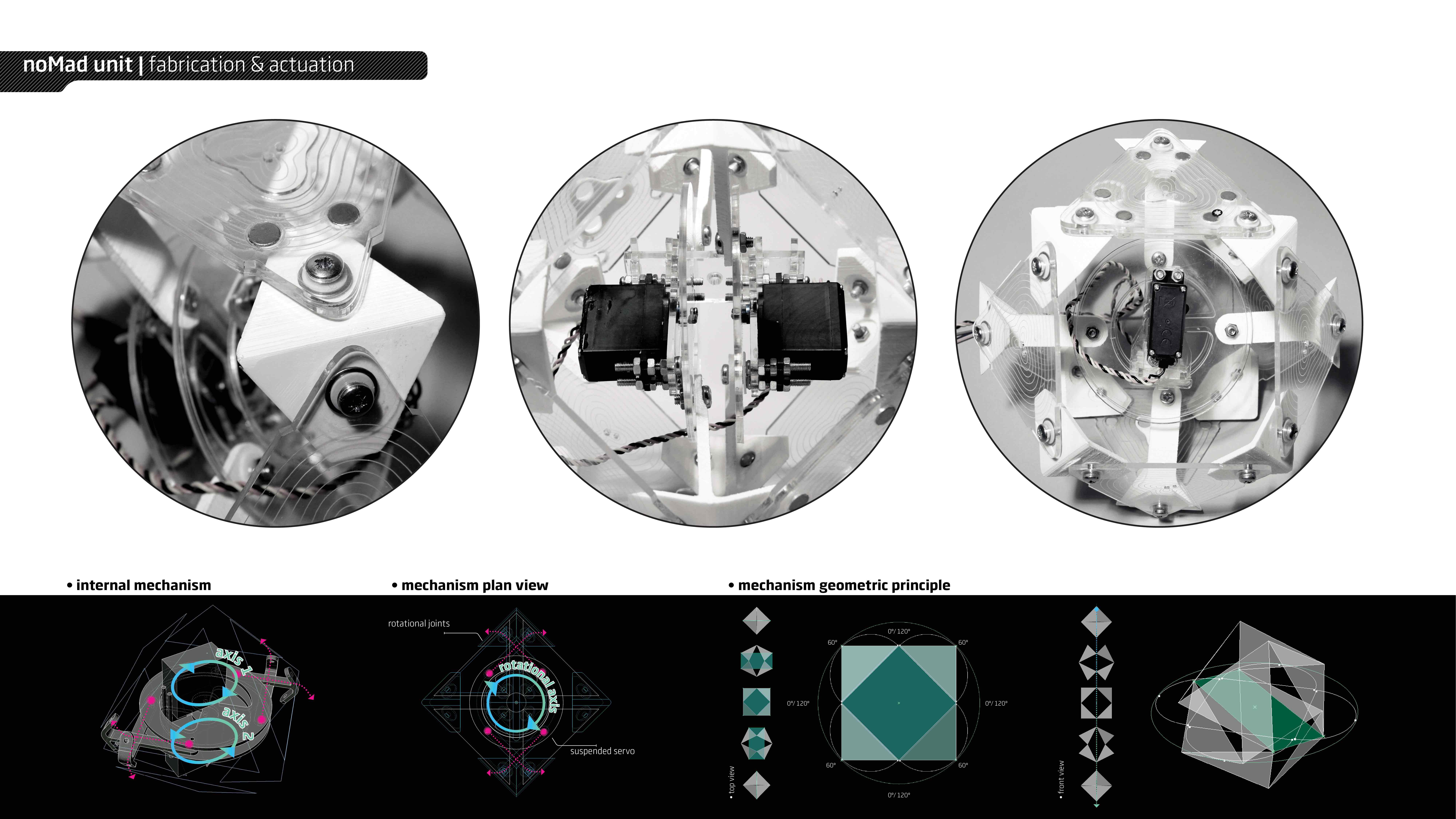
Communication based Behaviour |
In order to define the system’s internal motivation or performative criteria, particular problem-solving, goal oriented simulations are developed, emulating be- havioural and communicational aspects of the system. A computational abstraction model of physical geometry is utilized to emulate the behavioural and communica- tional aspects of the system. In these automated, goal oriented movement sequences, the communication between multiple bodies is driver for decision making. These simulations are driven by individual scenarios and situational responses. Bevavioural based simulations are conducted within a minimal framework of constraints like its reference to the groundplane. In course of the experiments, the system creates a self-imposed context to react to (such as maximum number of possibly arrayed passives without active unit or self-interlocking) to achieve a specific goal (finding another, reaching or avoiding an area of poential settlement, building up etc), As we are proposing to create a system that can self-regulate and adapt, but is not closed in itself but can also react to outside influences and demands, the research seeks to define both internal and external stimuli, encouraging both interaction and communication.
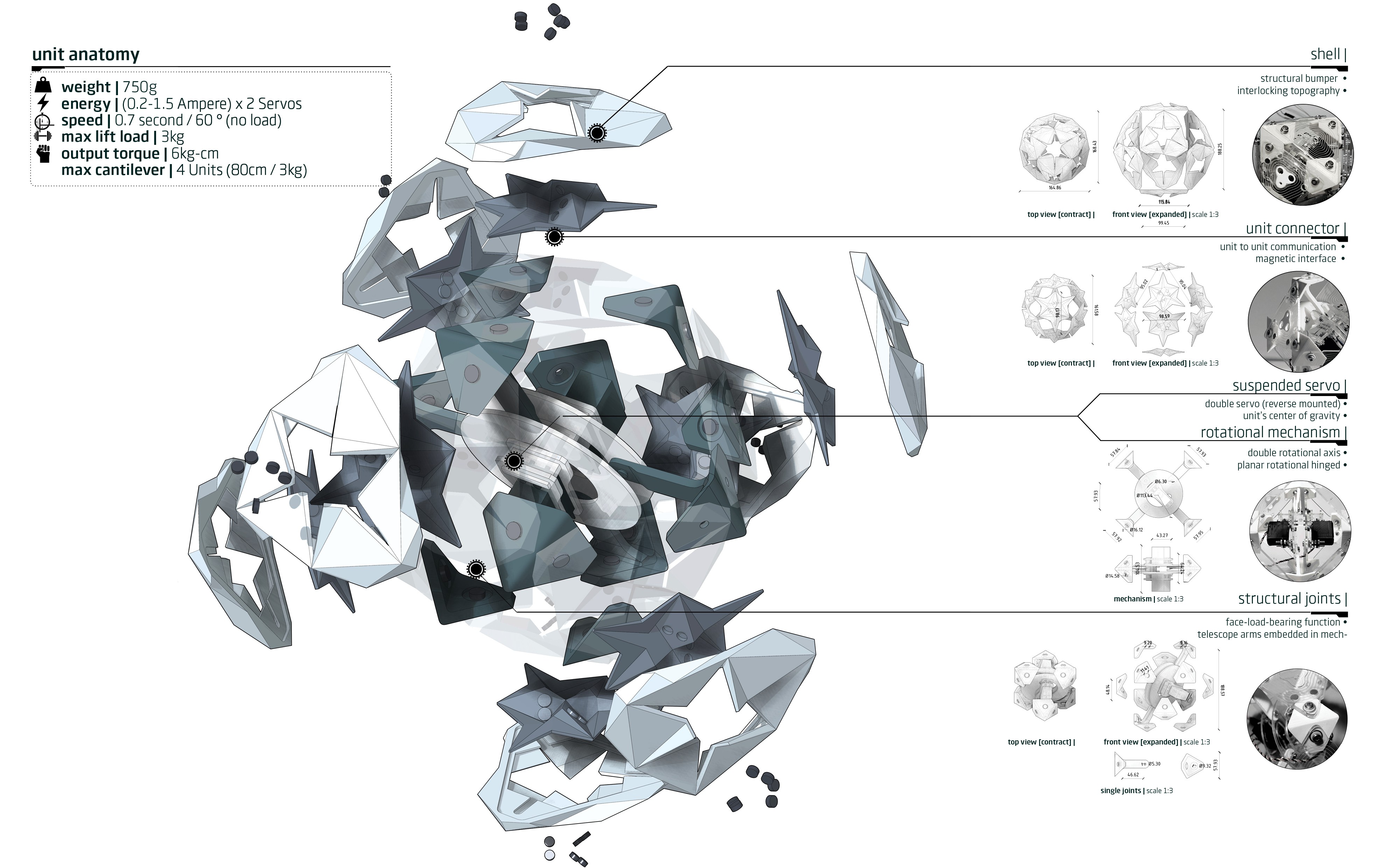
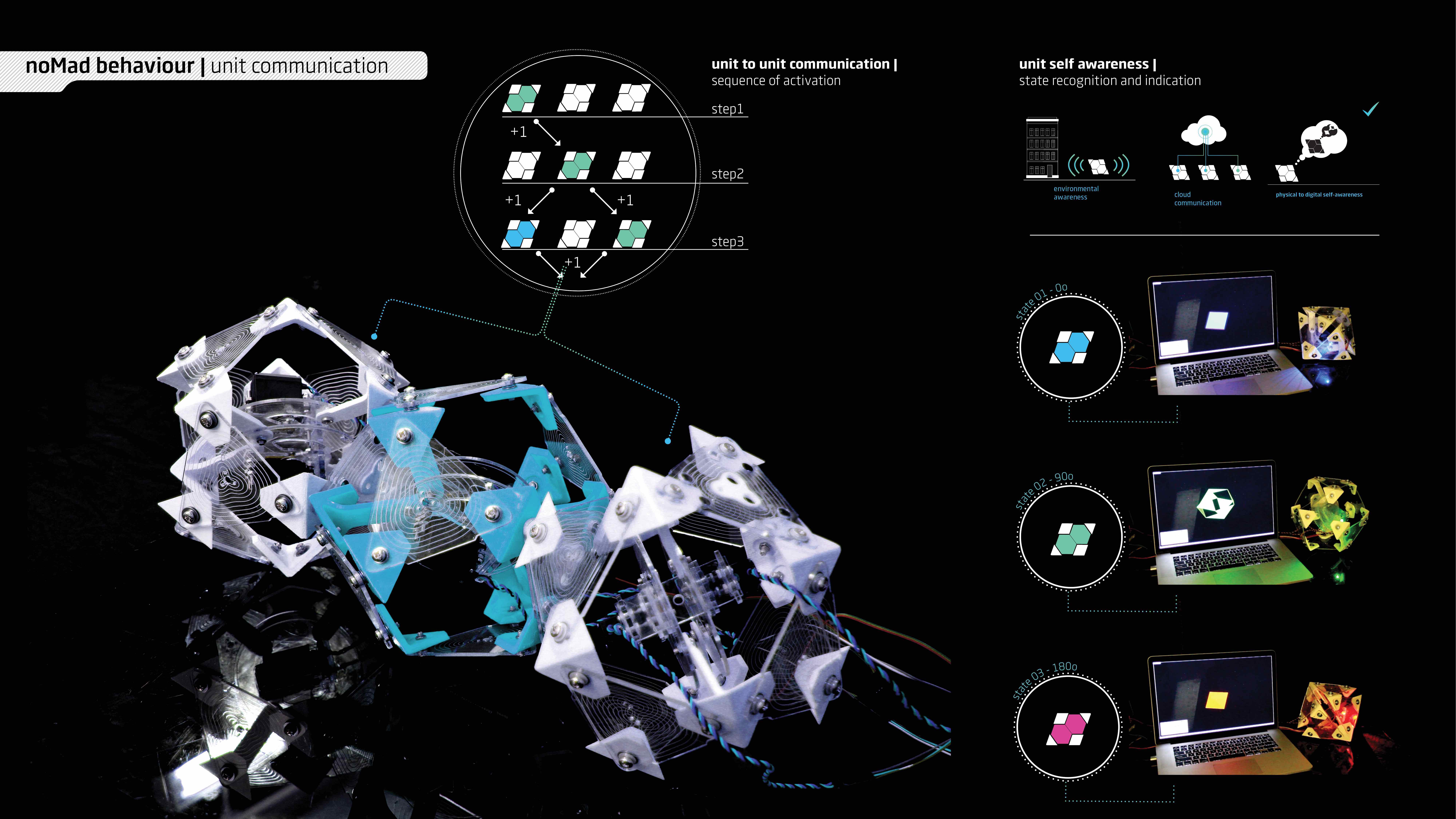
______________________________________________
BART//BRATKE:
Paul Clemens Bart
Marvin Bratke
a design by:
Dmytro Oleksandrovych Aranchii
Paul Clemens Bart
Iris Yugiu Jiang
Flavia Ghirotto Santos
developed at the AADRL at Theodore Syropoulos' Studio.
_______________________________________________
 Bart//Bratke
Bart//Bratke